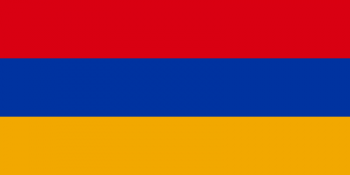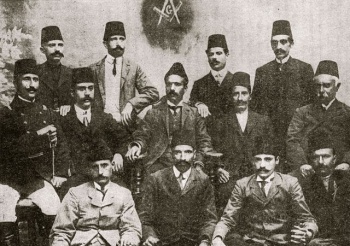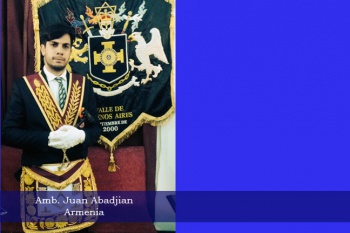En: The Freemasons of Armenian Origin
The Freemasons of Armenian Origin
By Juan Augusto Abadjian
Source: Association of Masonic Arts
Armenians have been one of those people who maintained their culture and traditions almost intact from antiquity to the present day. Through centuries they’ve adapted to dozens of different currents of thought and suffered persecutions of all kinds because of religion and geographic position. From an ancient Indo-European origin, they have forged their own language and coined a vast pagan history until they became the first nation that accepted Christianity as the Official State Religion. (c.301).
From ancient times, in the Armenian Plateau, in the Caucasus and in the whole of Anatolia, many brotherhoods and initiation orders have developed. These “brotherhoods”, whether of a religious, political or social character, created dominant cultures and emerging subcultures for hundreds of year in Asia Minor. the Tondrakian and the Paulician[1] movements that followed Christian teachings very close to Manichaeism; the Knights Templars; Hospitallers and Teutonic Knights, important actors during the Armenian Kingdom of Cilicia[2]; the Children of the Sun (Arevortik)[3], an Armenian neo-pagan heresy of the 13th century; as well as the polemic Hashashin. All of them have developed in the territory of Historical Armenia. Also in historic Armenia, the “operative freemasonry,” that is to say, the pure architectural masonry, has created master craftsmen, superb stonecutters and cathedral builders who reached their peak during the Middle Ages. Important historic characters such as Trdat, Momik, Sarkis and Manvel, among others, left their trace through signatures, signs and secret symbols spread in the hundreds of monuments, churches and stone crosses (Khachkars) still decorating the Armenian Republic and its neighboring countries[4]. Some of these builders were traveling masons who have left their mark in numerous churches throughout Europe and Asia.
The History of the Armenian Freemasons begins under the auspices of the United Grand Lodge of England. The English “East India Company” introduced freemasonry of English origin in Madras (now Chennai) in 1730. Many Armenian merchants who were already established tradesmen in India and Southeast Asia also played an important role in the East India Company[5]. They followed the English rules of conduct and often traveled throughout Europe and, at the same time, had ascended in the Indian social strata.
As the first instance of an active member of Armenian origin in one of the Informative Bulletins of the Cannon-gate Lodge in Edinburgh, (1762) it is stated that “… four Worshipful Masters would represent the United Grand Lodge of England in the territories of the Middle East, Aleppo and Iran…” Among those four persons, it was the name of the Armenian Dr. Manasse[6] who was appointed as Provincial Grand Master for “Armenia” by order of the Grand Master of the Premier Grand Lodge of England, Earl Ferrers, from 1762 to 1764. Until 1805, when the name of Manasse officially disappeared, the group of four lodges headed by these Worshipful Masters was called “All Armenia in the East Indies”[7] — remarkable for this period, the foundation of the First Lodge composed of members of Armenian origin.
On October 6th 1837, in the city of Madras, Colonial India, the Lodge “Armenian” No. 685 was consecrated under the auspices of the United Grand Lodge of England. This lodge had a brief life (1865) as a result of ups and downs in its activities. It was linked to prestigious families of established Armenian merchants in that city. The Lodge “Armenia” No. 685 worked in the Armenia Street in that city.
The last Masonic link of Armenian origin, and of relevant importance in Victorian India, was Sir Paul Chater (Khachik Pogos Astvatsatoor). Born in Calcutta in 1846, he was a prestigious and successful man who developed all his potential in imperial Hong Kong. He has been Worshipful Master of the Lodge “Perseverance” No. 1165, Grand Master of the Hong Kong District and the South of China for the United Grand Lodge of England (1881-1909), one of the first Armenian masons in having the Masonic High Degree 33° and, even today, the District of the United Grand Lodge of England for Hong Kong and the Far East auspices a lodge called “Paul Chater Lodge of Installed Masters” No. 5391. Undoubtedly, he was one of the masons of Armenian origin who had reached one of the highest points on the scale of Regular Freemasonry.
Closer to Historic Armenia, during the Ottoman Empire, the upper classes of Armenians had begun to interact defending the ideas proclaimed by the West, “Liberty, Equality and Fraternity”. At the same time, the Grand Masonic Powers (whether Grand Lodges or Grand Orients) planned the mission of westernizing the region and founding as many Masonic lodges as they could. The Grand Orient of Italy, the Grand Lodge of Scotland, the United Grand Lodge of England and the Grand Orient of France worked actively to spread the formation of Masonic lodges in the heart of the Empire.[8]
The right moment had come for the Armenians to plant the foundation of the first Armenian-speaking Lodge. That first one was born in Izmir (Smyrna) on June 5, 1864. The Lodge “Metsn Tigran” (or Decran Lodge) No. 1014 was installed under the auspices of the United Grand Lodge of England. Then on February 22nd, 1866, in the district of Pera, Istanbul, the foundation of the Lodge “Ser” (Love) took place under the patronage of the Grand Orient of France (Regular at the time). Hundreds of Armenians were initiated in both Lodges, which worked continuously until the first years of the last decade of the nineteenth century, when Sultan Abdul Hammid II started the terrible repression of the Armenian Nation throughout the Empire. The members of these lodges had been the lights in the cultural revival of the Armenian nation with a net influence up to these days. Other Lodges of less relevance at the time were “Armenak” (1872, Izmir, Grande Oriente d’Italia) and “Ararat” No. 76 (1882, Cairo, National Grand Lodge of Egypt).
During the early years of the twentieth century, the Armenians had the opportunity to join a Masonic lodge once again. In the Ottoman Empire, in Hyusenig (Kharpert-Harpout), among the cities with a high density of Armenian population, many Armenian “brothers” presented a petition to the Grand Lodge of Scotland to found a new lodge, “Euphrates” No. 1078 (Yeprad Lodge, 1910, Harpout, Mamuret Al Aziz). Paradoxically, of the nearly forty members that were part of this lodge, only one would survive the tragic events suffered by the Armenian people during the Genocide that started in 1915. The Masonic certificate of this surviving brother is still intact in the hands of his descendants. The last attempt of the Armenians living in the Ottoman Empire to create a Masonic Lodge was in 1919, when after World War I, on May 1, a group of brethren received the Charter from the Grand Lodge of Scotland, consecrating the Lodge “Hayastan” No. 1185. Although it had over a hundred members (125), this Lodge tiled its door for the last time in 1923, again due to the new political situation at the onset of the formation of the new Republic of Turkey. The Rituals in the Armenian Language of this Lodge are still available in the Library of the UGLE.
Following the devastating events that occurred between 1915 and 1923 to the Armenian population of the Ottoman Empire, they tried to rebuild their lives and re-settle in the countries to which they were forced to emigrate. The Great Armenian Diaspora was born and the Armenians were scattered throughout the four corners of the globe. On the other hand, the first Republic of Armenia (1918-1921), that would have several ministers who were members of lodges in the Grand Orient of France (Simon Vratzian, Alexandre Khatissian, to name two), would lose its sovereignty against the Red Army and become a Soviet Republic, thereby finding itself into an anti-Masonic context. That is why, until the decade of the 50’s, no large concentrations of Armenian Freemasons occurred except in isolated and individual cases (Michael Apcar, 33º. Yokohama, Japan, or Noradunghian Mihail, 33º, Romania).
The following Lodges were born in cities that were distant from the Armenian Homeland. “Ararat” No. 582 (1952, Grand Lodge of Michigan, USA), “Ararat” No. 404 (1957, Grand Lodge of Argentina, Buenos Aires, Argentina), “Ani” No. 11 (1959, District Grand Lodge of New York, Beirut, Lebanon), “Mount Ararat” No. 9239 (1987, UGLE, Surrey, England), “Ararat” No. 738 (1993, National Grand Lodge of France (GLNF), Aubagne, France), “Hayastan” No. 94 (1994, Grand Lodge of the District of Columbia, USA), “Arménie Hayastan” No. 957 (1995, National Grand Lodge of France, Paris, France), “Northern Lights” No. 9 (1995, Grand Lodge of Russia, Moscow, Russia), “Lumières D’Ararat” No. 1049 (1997, GLNF, Lyon, France) and “Urartu” No. 442 (2000, Grand Lodge of Argentina, Buenos Aires, Argentina).
The most significant aspect of this series of events is to appreciate the fact that from that diaspora came the most important event of this story: the Birth of the Grand Lodge of Armenia.
Hayastan Lodge No. 94 in Washington DC began preparations for this dream. On December 16, 1999 the Grand Lodge of the District of Columbia, to which Hayastan No. 94 belongs, gave birth to the Sojourning Lodge “Massis” No. 99. With the additional participation of the National Grand Lodge of France and the Grand Lodge of Russia, took place the project of creating the Grand Lodge of Free and Accepted Masons of Armenia. To that end, in May 2001 the “First World Conference of Armenian Masons” was held. There, all issues pertaining to the big step of consecrating this Grand Jurisdiction were settled. Mason brethren from the United States, Lebanon, Russia, France, United Kingdom and Argentina were present at the this Conference.
For the same purpose as the creation of “Massis” Lodge, the National Grand Lodge of France created the Lodge “France-Arménie” while the Grand Lodge of Russia founded, on December 4th 2001, Lodge “Ser” (Love) No. 18. All of them were founded for the same objective: the foundation of a new Regular Grand Lodge for all the Armenians.
On the historical day of July 30, 2002, in the capital city of Yerevan, the Grand Lodge of Free and Accepted Masons of Armenia was ceremoniously consecrated by the three Grand Lodges mentioned above.
After decades, and for the first time in history, “Armenian freemasonry” had its own Masonic Jurisdiction and Autonomy in its native land.
As stated in its Constitution, the Grand Lodge of Armenia works regularly respecting the ancient landmarks of Regular Freemasonry. Its Constitution also provides for the performance of Masonic Tiled Meetings in three ritual rites: Emulation Ritual, York Ritual and Ancient and Accepted Scottish Rite. In 2002, the first four founding lodges were established: “Massis” No. 1, “France–Arménie” No. 2, “Ser” No. 3 and “George Washington” No. 4. The first three coming from the Jurisdictions of the three founding Grand Lodges, namely; Grand Lodge of the District of Columbia, National Grand Lodge of France and Grand Lodge of Russia respectively. The first Grand Master was the Most Worshipful Brother Christopher Sahakian, succeeded by the MWB Armen Janian, MWB Armen Garabedian, MWB Armen Simonian and MWB Gilbert Stepanian, the present Grand Master of the Grand Lodge of Armenia.
In the philanthropic and social field, the Grand Lodge of Armenia founded “Noah’s Children Charity” by means of which, year after year, a great many philanthropic activities to help those in need are made.
In July 2008, the Supreme Council of the 33° for Armenia, was founded and consecrated. Its first Sovereign Grand Commander was the Illustrious and Very Powerful Brother Christopher Sahakian. Both the foundation of the Grand Lodge of Free and Accepted Masons of Armenia and the Supreme Council 33° for Armenia opened a way in being the first Caucasian state in having these institutions. The Armenian Supreme Council is composed of the “Lodges of Perfection”, “Chapter Lodges”, “Areopagus”, and “Consistory”.
Today the Grand Lodge of Armenia of Free and Accepted Masons has over 11 Lodges working and has a global structure sustained by Brethren of the Armenian diaspora and enriched by new members that are constantly being initiated in the land of the young Free Republic of Armenia (est. 1991). Meanwhile, Armenian Diaspora Lodges are still being born.
Within a few years, there would be three centuries of speculative freemasonry. Among Armenians the Craft has accomplished its mission of surviving and working constantly regardless of political, geographic and cultural problem that it was subjected to.
About Juan Augusto Abadjian
Assistant Grand Master and Grand Inspector for South America and the Inter-American Masonic Confederation (CMI) for the Grand Lodge of Armenia. Honorary Member and Worshipful Master AD VITAM of the Lodge Urartu No. 442 under the Jurisdiction of the Grand Lodge of Argentina.
Member of the Lodge Massis No. 1 under the Jurisdiction of the Grand Lodge of Armenia.
Attorney at Law, University of Buenos Aires.
Footnotes
- [1] For a deeper knowledge on these brotherhoods see: Dadoyan, Seta B.: “The Fatimid Armenians: cultural and political interaction in the Near East”. New York: Brill, 1997. Chapter III.-
- [2] Regarding the interaction of the Kingdom of Cilicia and the Templar Knights see: “Mutafian, Claude, “Le Royaume Arménien de Cilicie, XIIe-XIVe siécle”. CNRS ÉDITIONS, Paris. 1993,2001.-
- [3] Dadoyan, pages 72-75.-
- [4] Barkhurtaryan, “Armenian Architects and Stonecutter Masters from the Middle Ages” Բարխուդարյան, Ս. «Միջնադարյան Հայ Ճարտարապետներ և Քարգործ Վարպետներ». Երեվան. Հայկական ՍՍՌ ԳԱ Հրատարակչություն. 1963. Specially Chapter V.
- [5] See: Baladouni Vahé, Margaret Makepeace, East India Company. “Armenian merchants of the seventeenth and early eighteenth centuries: English East India Company sources”. American Philosophical Society, 1998.
- [6] Berberian, Ruben. “The Armenian Freemasons and the Lodge SER of Constantinople” Բերբերեան, Ռուբէն. «Հայ Մասօնները և «Սէր» Օթեակը Պոլսոյ Մէջ», Հայրենիք. Պոսթըն. Մարտ-Յունիս 1937. April edition, page 128.
- [7] See Gould, Robert Freke. “A Library of Freemasonry : comprising its history, antiquities, symbols, constitutions, customs, etc., and concordant orders of Royal Arch, Knights Templar, A. A. S. Rite, Mystic Shrine, with other important Masonic information of value to the fraternity derived from official and standard sources throughout the world from the earliest period to the present time”, John C. Yorston Publishing Company. London. Philadelphia. Montreal. 1906. Page 125.
- [8] This topic is clearly dealt with in Dumont, Paul: “Freemasonry in Turkey: a by-product of Western penetration,” European Review, Cambridge University Press, vol. 13(03), pages 481-493, July.




